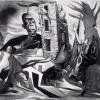4: Lithograph, Boris Gorelick’s "Lynching," 1936-1937.
Boris Gorelick (1909-1984) was a painter, muralist, and animator who immigrated to the United States from Russia with his parents at the age of four. He attended the National Academy of Design, the Arts Students League and Columbia University and was the founder and president of the Artist’s Union, an organization promoting American art during the Great Depression. He worked for the Works Progress Administration on a lithograph project in 1933 and became a member of the New York lithography workshop. He later moved to California where he became an animator for Playhouse Films and taught art classes at Otis Art Institute. Gorelick created Lynching after reading a newspaper story about the lynching of a young black man. His abstract representation of the event expressed his protest against such violence and hatred (Baigell 161). Teachers working with this resource may also wish to turn to this set of lesson plans on Race Relations from the Columbus Museum of Art, which features Gorelick’s lithograph. Because of the very sensitive nature of this topic, teachers may wish to turn to additional sources for background about Jewish representations of the lynching of African Americans in this period. This book by Milly Heyd about artistic representations between Jews and Blacks is a good place to start.
Suggested Activities: Have your students look at the lithograph. Go around the room and have students identify what is happening in different sections of the drawing. Ask your students: Why would a Jew from New York be interested in southern racism? What did Jews and African-Americans have in common at the time? Ask your students to discuss their emotional response to the lithograph. How is looking at an abstract artwork different from reading an account about lynching in a history book?
Source: Boris Gorelick, Lynching, lithograph, WPA-FAP, ca. 1937.
Gorelick_Strange-Fruit_pg.jpg
 Download image (107.04 KB)
Download image (107.04 KB)

